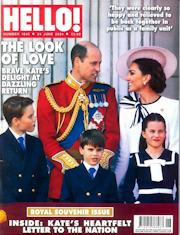Food and lifestyle blogger Alison Maclean from Dragons and Fairy Dust tells us how reading Digital Photographer has given her a new enthusiasm for photography...
Recently I’ve been trying to learn more about photography. I’ve used a camera since the days of film and black and white images, but because I’ve always used my camera for snapshots, I never really learned about the different camera settings and how they influence the picture. This has all changed, however, as I have signed up for a photography course and am learning more each day.
I’ve also been reading Digital Photographer, a magazine for photography enthusiasts and professionals which helps you refine your skills. I did worry I would be a little out of my depth reading it but I wasn’t; it both inspired and challenged me and I learnt a lot. Here are five key things I’ve learned from reading photography magazines:
Photography is an art
Photography is more than a single shot showing a scene - it is an art. The art lies in the way the photographer has framed the image, and the photographer must pick the subject, choose the foreground and background and arrange the shot in a way that is pleasing. Different people could take pictures of the same thing and the resulting picture would be very different.
The art lies in the way the picture has been interpreted. Garry Winogrand, a famous street photographer from the Bronx, was a prolific photographer who left behind 2,500 rolls of unprocessed film when he died. He said, “I photograph to see what the world looks like in photographs.” That is the key; the world looks different in photographs and the way it looks is down to the photographer.
Light matters
Light can really change the way a photograph appears, and the light at different times of day can make a scene look vastly different. The period just after sunrise or before sunset is known as the golden hour - where sun is redder and softer in the sky and the light is diffused and flattering.
From these magazines I also learnt that there is a blue hour - the time when the sun has gone beyond the horizon and the sky becomes a deep blue. Once I knew this I started noticing it and even managed to capture a photograph depicting the blue hue in the sky. Knowing about light and how it falls will help you capture stunning photographs.
Become familiar with your subject
Whatever you take photographs of - wildlife, people or landscapes - it’s worth taking time to become familiar with it first. Wildlife photographers spend a lot of time observing animals and learning about their behaviour and habits. If you know where an animal lives and when it comes out then you’re more likely to capture a good photograph of it. The same applies to landscapes; if you’re familiar with the area and how it looks at different times of year then you’re more likely to be able to take a good photograph.
It’s worth going to a place without your camera and just sitting and observing. You can see what the wildlife is doing and when it is active, see how the light changes and all the while plan how to best take photographs. Visualising photographs in your mind is a great discipline and makes it much easier to take the perfect shot when you do have your camera.
Black and white can be expressive
Black and white pictures always take me back to the days when I took photos as a child. We were given black and white film and my dad would develop it himself. Black and white photography is considered an art form. When you use black and white you become more aware of the light and shadow and can use it to create a photograph with expression.
Black and white photographs can also be more atmospheric. I find that black and white photographs of people are better at capturing the details of expression and allowing you a glimpse into their soul. I love looking at street photographs from the sixties - they have a sense of style that shooting in black and white can help you recapture today.
Develop your own style
Every photographer has their own style and this is not something that can be learned. The only way you can develop a photographic style is by taking photographs. You can look at what others have done and learn from them, but it’s only by practice that you can develop your own feel to a photograph - something distinctive that will make people aware that you took the photo.
I am hoping to keep learning from photography magazines - and hopefully one day people will recognise that I am the person who took a particular photo too.









